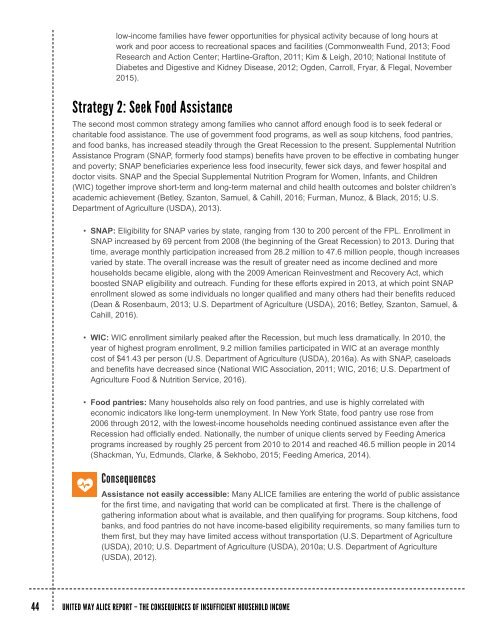The Consequences of Insufficient Household Income
This new Consequences of Insufficient Household Income report provides a deeper level of understanding of the choices that ALICE and poverty-level families across the country make when they do not have enough income or assistance to afford basic necessities, and the consequences of those choices.
This new Consequences of Insufficient Household Income report provides a deeper level of understanding of the choices that ALICE and poverty-level families across the country make when they do not have enough income or assistance to afford basic necessities, and the consequences of those choices.
Create successful ePaper yourself
Turn your PDF publications into a flip-book with our unique Google optimized e-Paper software.
low-income families have fewer opportunities for physical activity because <strong>of</strong> long hours at<br />
work and poor access to recreational spaces and facilities (Commonwealth Fund, 2013; Food<br />
Research and Action Center; Hartline-Grafton, 2011; Kim & Leigh, 2010; National Institute <strong>of</strong><br />
Diabetes and Digestive and Kidney Disease, 2012; Ogden, Carroll, Fryar, & Flegal, November<br />
2015).<br />
Strategy 2: Seek Food Assistance<br />
<strong>The</strong> second most common strategy among families who cannot afford enough food is to seek federal or<br />
charitable food assistance. <strong>The</strong> use <strong>of</strong> government food programs, as well as soup kitchens, food pantries,<br />
and food banks, has increased steadily through the Great Recession to the present. Supplemental Nutrition<br />
Assistance Program (SNAP, formerly food stamps) benefits have proven to be effective in combating hunger<br />
and poverty; SNAP beneficiaries experience less food insecurity, fewer sick days, and fewer hospital and<br />
doctor visits. SNAP and the Special Supplemental Nutrition Program for Women, Infants, and Children<br />
(WIC) together improve short-term and long-term maternal and child health outcomes and bolster children’s<br />
academic achievement (Betley, Szanton, Samuel, & Cahill, 2016; Furman, Munoz, & Black, 2015; U.S.<br />
Department <strong>of</strong> Agriculture (USDA), 2013).<br />
• SNAP: Eligibility for SNAP varies by state, ranging from 130 to 200 percent <strong>of</strong> the FPL. Enrollment in<br />
SNAP increased by 69 percent from 2008 (the beginning <strong>of</strong> the Great Recession) to 2013. During that<br />
time, average monthly participation increased from 28.2 million to 47.6 million people, though increases<br />
varied by state. <strong>The</strong> overall increase was the result <strong>of</strong> greater need as income declined and more<br />
households became eligible, along with the 2009 American Reinvestment and Recovery Act, which<br />
boosted SNAP eligibility and outreach. Funding for these efforts expired in 2013, at which point SNAP<br />
enrollment slowed as some individuals no longer qualified and many others had their benefits reduced<br />
(Dean & Rosenbaum, 2013; U.S. Department <strong>of</strong> Agriculture (USDA), 2016; Betley, Szanton, Samuel, &<br />
Cahill, 2016).<br />
• WIC: WIC enrollment similarly peaked after the Recession, but much less dramatically. In 2010, the<br />
year <strong>of</strong> highest program enrollment, 9.2 million families participated in WIC at an average monthly<br />
cost <strong>of</strong> $41.43 per person (U.S. Department <strong>of</strong> Agriculture (USDA), 2016a). As with SNAP, caseloads<br />
and benefits have decreased since (National WIC Association, 2011; WIC, 2016; U.S. Department <strong>of</strong><br />
Agriculture Food & Nutrition Service, 2016).<br />
• Food pantries: Many households also rely on food pantries, and use is highly correlated with<br />
economic indicators like long-term unemployment. In New York State, food pantry use rose from<br />
2006 through 2012, with the lowest-income households needing continued assistance even after the<br />
Recession had <strong>of</strong>ficially ended. Nationally, the number <strong>of</strong> unique clients served by Feeding America<br />
programs increased by roughly 25 percent from 2010 to 2014 and reached 46.5 million people in 2014<br />
(Shackman, Yu, Edmunds, Clarke, & Sekhobo, 2015; Feeding America, 2014).<br />
<strong>Consequences</strong><br />
Assistance not easily accessible: Many ALICE families are entering the world <strong>of</strong> public assistance<br />
for the first time, and navigating that world can be complicated at first. <strong>The</strong>re is the challenge <strong>of</strong><br />
gathering information about what is available, and then qualifying for programs. Soup kitchens, food<br />
banks, and food pantries do not have income-based eligibility requirements, so many families turn to<br />
them first, but they may have limited access without transportation (U.S. Department <strong>of</strong> Agriculture<br />
(USDA), 2010; U.S. Department <strong>of</strong> Agriculture (USDA), 2010a; U.S. Department <strong>of</strong> Agriculture<br />
(USDA), 2012).<br />
44 UNITED WAY ALICE REPORT – THE CONSEQUENCES OF INSUFFICIENT HOUSEHOLD INCOME




